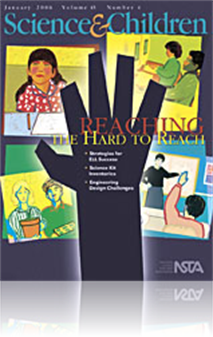All Science and Children resources
Journal Article
Science 101: How can hands-on science teach long-lasting understanding?
Hands-on science activities have long been touted as a great way to motivate students who otherwise might not be all that interested in science. This article discusses the art of tapping into successful discovery learning through structured inquiry....
Journal Article
Teaching Through Trade Books: Crazy for Loco Beans
Do you remember your amazement the first time you watched a Mexican jumping bean hop around in the palm of your hand? Investigating "jumping beans" is a unique way to get your students engaged in scientific inquiry. In this month's column, students...
Journal Article
Methods and Strategies: A New Use for Semantic Maps
Semantic maps are frequently used graphic organizers that help students analyze their reading or develop their vocabulary. However, semantic maps can also be used effectively as a preassessment strategy for science teaching....
Journal Article
The Early Years: The Matter of Melting
This month's Early Years column reveals how establishing a shared language through experiences can help young students and teachers exchange ideas and information about science concepts. The experiences that occur as part of this month's activity ex...
Journal Article
On Dinosaur Day, first-grade students rotated through four dinosaur-related learning stations that integrated science content with art, language arts, math, and history in a fun and time-efficient manner. The event drew parents, teachers, and student...
Journal Article
A science kit inventory introduces students to tools and vocabulary, paving the way for successful science experiences. While it is an effective strategy for all students, it is especially useful for English Learners. This article describes how kit i...
Journal Article
Learning Logs: Writing to Learn, Reading to Assess
Good inquiry activities help students hone their inquiry abilities and teach them about the nature of science. Inquiry is also a way to teach science content, and teachers need to know if this instruction is helping children gain these important ide...
Journal Article
Teaching Through Trade Books: From Sap to Syrup
Warm days, cold nights, melting snow—signs winter is waning and spring is nearing. Though winter may just be getting started in your area, it’s always fun to appreciate the good things about winter, including the special time at the end of winter...
Journal Article
Learning to write well is a long process that comes through teacher modeling, instruction, practice, and feedback. Luckily, the writing process can be used to improve science learning too. This article describes how nonfiction writing activities hel...
Journal Article
Science 101: What writing represents what scientists actually do?
This article addresses whether or not a report based on scientific method accurately represents what scientists do as well as what kind of writing scientists engage in that goes beyond the reporting of conclusions....
Journal Article
Science Shorts: Seeing What We Can’t See
While observation is critical to science, sometimes we cannot observe things directly. Sometimes things happened long ago (in paleontology, for example) or are too small to observe (like atoms). Many students believe that science progresses only thro...
Journal Article
The Early Years: The Nuts and Bolts of Discovery Centers
Young children are born scientists, exploring everything in their world around them. Yet, many teachers still find it hard to integrate science into the daily schedule. However, open-ended science or discovery centers are a perfect way for teachers t...



